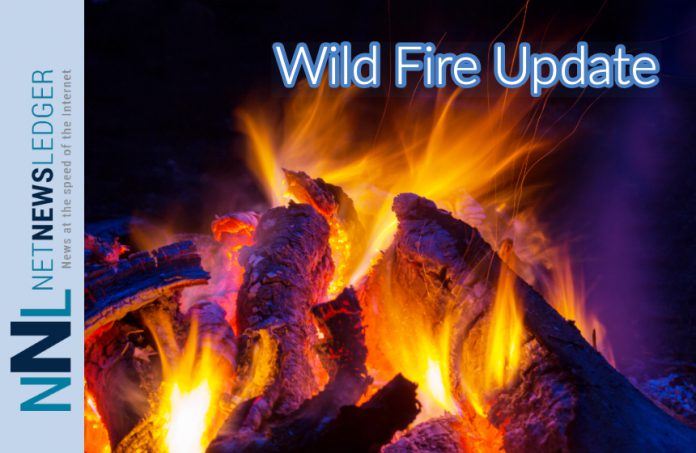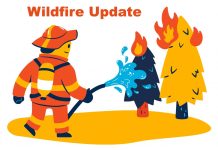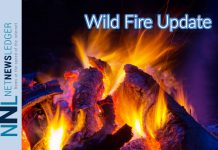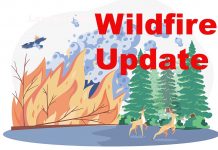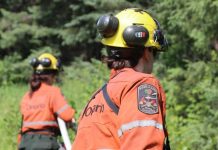FOUR New Fires Confirmed in the Northwest Region
THUNDER BAY – Wildfire Update – By the early evening of June 28, four new fires were confirmed in the Northwest Region, adding to the ongoing firefighting efforts. The details of the newly discovered fires are as follows:
- Nipigon 27 and Nipigon 28: Located near Luella Lake, approximately 70 km southwest of Eabametoong (Fort Hope) First Nation, both fires measure 0.1 hectares and remain uncontrolled.
- Sioux Lookout 59: Positioned at the community of Angling Lake First Nation, approximately 23 km east of Kitchenuhmaykoosib Inninuwug First Nation (Big Trout Lake), this fire is under control at 0.1 hectares in size.
- Sioux Lookout 60: Situated near Zeemel Lake, roughly 125 km north of Pickle Lake, this fire spans 2.5 hectares and is currently not under control.
Additionally, another fire was discovered in the evening hours of June 27:
- Sioux Lookout 58: Found near the Fawn River, approximately 7.6 km north of Angling Lake First Nation, this fire covers an area of 10 hectares and remains uncontrolled.
Active Fires and Fire Hazard Conditions
As of this update, the Northwest Region reports a total of 46 active fires. Out of these, 12 fires remain uncontrolled, four are being held, five are under control, and 25 fires are being observed. The fire hazard levels in the region vary, with southern areas such as Kenora, Fort Frances, Dryden, Thunder Bay, and most of the Red Lake sector experiencing low to moderate hazard conditions. On the other hand, the Sioux Lookout and Nipigon sectors face a high hazard with pockets of extreme conditions. Stay informed about the fire hazard conditions in your specific area by referring to our Interactive Map.
Notable Fires in the Northwest Region
Several fires of note require particular attention within the Northwest Region:
- Sioux Lookout 33: Located on the western edge of Wabakimi Provincial Park, this fire spans 51,000 hectares and remains uncontrolled. Ongoing assessments and protection efforts are in progress, with ignition opportunities being evaluated.
- Nipigon 13: Situated west of Ogoki Lake, this fire covers an extensive area of 30,639.3 hectares and remains uncontrolled. Values assessment and protection efforts continue, and further ignition opportunities will be assessed.
- Sioux Lookout 53: Sized at 294 hectares, this fire remains uncontrolled. Air attack operations have been actively working on the fire for the past few days. The fire is situated 3.5 km east of Bearskin Lake First Nation.
- Nipigon 19: Covering an area of 8,705.83 hectares, this fire remains uncontrolled. Helicopter bucket operations were conducted yesterday to limit the fire’s spread in priority areas.
- Sioux Lookout 44: Located on the west side of St. Joseph Lake, this fire spans 4,159 hectares and is currently not under control. Successful ignition operations were carried out yesterday.
- Red Lake 28: Positioned 40 km North of Lac Seul First Nation, this fire measures 18,029 hectares and remains uncontrolled. Helicopter bucket operations focused on the southeast end of the fire yesterday.
Restricted Fire Zone
Due to the extreme forest fire hazard, the Ministry of Natural Resources and Forestry has declared a Restricted Fire Zone for the entire fire region of Ontario (Zones 1 to 36). The Restricted Fire Zone is in effect until further notice. Restricted Fire Zones help protect public safety. Open air burning, including campfires, is not permitted within the boundaries of a Restricted Fire Zone. Portable gas or propane stoves may be used for cooking and warmth BUT must be handled with extreme caution. All burning permits are suspended.
Click the link for a map of areas affected by the Restricted Fire Zone.
Fireworks
Fireworks are an exciting part of summer, though during this time of escalated fire activity, we ask you to consider attending an organized fireworks venue instead of setting off your own. Fireworks are not restricted during the Restricted Fire Zone, though the Forest Fire Prevention Act (FFPA) states:
“No person who discharges a firearm, a flare, fireworks or explosives in or within 300 metres of a forest area shall leave any residue from the discharge unextinguished.”
During periods of hot, dry weather, sparks and embers can start forest fires. All fires are investigated to determine the cause. You can be charged under the Act and may be held responsible for the cost of putting the fire out. Check with your local municipality for additional municipal by-laws for fireworks.
Report a Wildland Fire
To report a wildland fire located north of the French and Mattawa rivers, please dial 310-FIRE. To report a forest fire located south of the French or Mattawa rivers, please dial 911.


